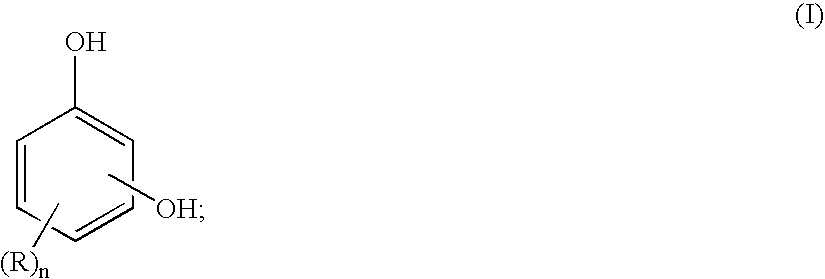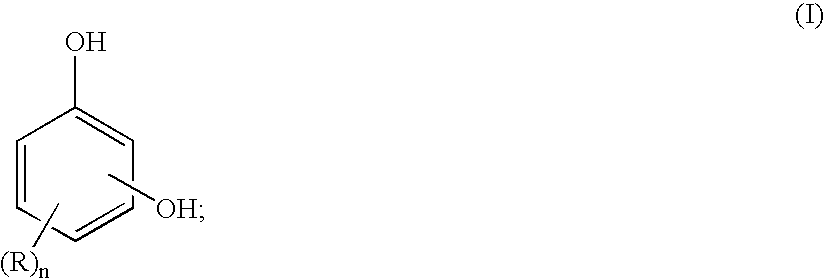Method of stabilization of dihydric phenols
a technology of dihydric phenols and stabilization methods, applied in the direction of flocculation/precipitation, water/sewage treatment, water/sludge/sewage treatment, etc., can solve the problems of dihydric phenol discoloration, quality problems, and lower commercial value of dihydric phenols, so as to prevent or reduce the discoloration of dihydric phenols
- Summary
- Abstract
- Description
- Claims
- Application Information
AI Technical Summary
Benefits of technology
Problems solved by technology
Method used
Image
Examples
examples
[0055]The following examples illustrate the advantage of adding specific amounts of oxalic acid as a stabilizer to dihydric phenols by demonstrating an improvement in the YI or dYI values of the polycarbonate prepared using the stabilized monomer.
[0056]Methyl hydroquinone (MeHQ) and Hydroquinone (HQ) used in the Examples were obtained from commercial sources, such as, for example, from Hunan, in China and from Shirdi Chemicals, in India. The samples were about 99 percent pure when analyzed using High Performance Liquid Chromatography (HPLC) using a Shimadzu 2010 HPLC instrument, based on weight percent. The starting sample of MeHQ and HQ is hereinafter referred to as raw MeHQ and raw HQ respectively.
[0057]The molecular weight (MW) of the co-polymer was determined by Gel Permeation Chromatography (GPC) technique. A Shimadzu system connected with a UV-detector (254 nm) was used for this purpose. A sample of the co-polymer was dissolved in chloroform and injected into a PLgel 5 microme...
examples 13 to 15
[0065]Polycarbonate terpolymers were prepared as follows. Bisphenol A (19.62 g) and HQ (4.05 g) and MeHQ (2.11 g), tetrabutylphosphonium acetate (TBPA; 0.001956 g), diphenyl carbonate (26.3 g) and oxalic acid (amount as provided in Table 1; added as a solution in 50 microliter water), were charged into a round bottom flask. The contents of the flask were then stirred to form a mixture. The mixture was then purged with nitrogen. The mixture was then heated to about 160° C. and maintained at this temperature for about 3 hours. The heating was then stopped and the dYI / YI of the resultant reaction mixture measured.
[0066]The YI / dYI values for the Examples and comparative Examples discussed above are included in Table 1 below. The term “NT” stands for “not-tested”.
[0067]
TABLE 1Co-polymer / Example No.MonomerTerpolymerOxalic acid in ppmMWPSdYIYI 1MeHQMeHQ / BPA46NT0.835NT 2MeHQMeHQ / BPA52NT0.831NT 3MeHQMeHQ / BPA80NT0.451NT 4MeHQMeHQ / BPA100NT0.566NT 5MeHQMeHQ / BPA163NT0.863NT 6MeHQMeHQ / HQ / BPA13471...
PUM
| Property | Measurement | Unit |
|---|---|---|
| thickness | aaaaa | aaaaa |
| yellowness index | aaaaa | aaaaa |
| temperature | aaaaa | aaaaa |
Abstract
Description
Claims
Application Information
 Login to View More
Login to View More - R&D
- Intellectual Property
- Life Sciences
- Materials
- Tech Scout
- Unparalleled Data Quality
- Higher Quality Content
- 60% Fewer Hallucinations
Browse by: Latest US Patents, China's latest patents, Technical Efficacy Thesaurus, Application Domain, Technology Topic, Popular Technical Reports.
© 2025 PatSnap. All rights reserved.Legal|Privacy policy|Modern Slavery Act Transparency Statement|Sitemap|About US| Contact US: help@patsnap.com



